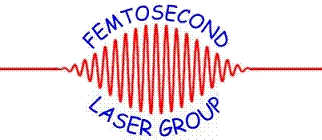Department of Physics and Astronomy: Publications and Other Research
Date of this Version
June 2000
Abstract
This paper presents ion yields resulting from multiphoton ionization and fragmentation of gaseous toluene (C7H8) in the focus of an 80 fs Ti:sapphire laser beam (λ = 800 nm) with a sufficiently small B-integral [Siegman, Lasers (University Science Books, Mill Valley, CA, 1986)]. The peak intensity was varied between 1.9x1013 and 2.8x1013Wcm-2, and both linear and circular polarization were used. Over the whole range of intensities studied, only the singly charged parent ion and its fragment, C7H7+, are found. Although the Keldysh adiabaticity parameter equals 0.86 for the saturation intensity of ~1x1014W cm-2, there is no indication of tunneling. The parent ion yield is found to be effectively proportional to the sixth power of the peak intensity. This is shown to be in good agreement with a multiple lowest-order perturbation multiphoton ionization model which takes into account successive channel closing for increasing peak intensities and orders up to 11 inclusive. On the assumption that the excess energy acquired by the toluene cation as a result of the interaction with the electromagnetic field is of the order of the ponderomotive energy for the intensity prevailing at the moment of the ionization, the internal energy distribution of the toluene cations created that is brought about by this multiple-order multiphoton ionization model is calculated. This internal energy distribution is in perfect agreement with the measured C7H7+ yield, if the rate-energy curve for the fragmentation of excited toluene cations as given by Golovin et al. [Sov. J. Chem. Phys. 2, 632 (1985)] is moderately reduced by a factor of 4.5.


Comments
Published by American Institute of Physics. J. Chem. Physics Vol. 112, No. 21, 1 June 2000. Copyright © 2000 American Institute of Physics. Permission to use.